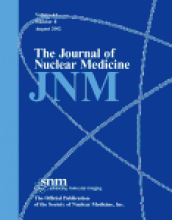TO THE EDITOR:
We would like to describe a recent clinical case that we think illustrates a simple and apparently new approach to solving what traditionally has been a difficult and time-consuming clinical problem. A full-term 59-d-old male infant presented to the Department of Nuclear Medicine for a thyroid scan as part of a work-up for possible ectopic thyroid tissue. The baby was born with several abnormalities of the oral cavity and nasopharynx, including a large cleft palate, a multilocular nasopharyngeal mass protruding into the cleft, a bifid tongue, and a 1 × 1.5 cm midline mass between the 2 lingual processes. Because of airway compromise, the palatal mass had been removed 1 wk earlier and was found to be a teratoma with elements of neurofibroma. The etiology of the lower mass remained unknown, and lingual thyroid tissue was within the differential diagnosis. A thyroid scan was ordered to confirm the presence of an orthotopically placed thyroid gland within the neck and to evaluate for the presence of iodide-concentrating tissue within the mass.
The baby was fed formula mixed with 2.8 MBq 123I NaI. Twenty-four hours later, radioactive iodide uptake over the neck, using an adult-sized phantom, was calculated to be 12.7%. Pinhole imaging was performed on the sleeping child in anterior and lateral projections. A single focus of uptake was noted and, after reimaging with markers, was thought to be localized in the neck and not the pharynx. The location of the activity was confirmed using an intraoperative cadmium-tellurium probe (Navigator GPS and Standard Lymphatic Mapping Probe; United States Surgical, Norwalk, CT), which was placed on the upper anterior neck, above the thyroid cartilage. Through rotation of the collimated detector, all the detectable counts were shown to originate inferiorly, from the usual location of the thyroid, and not posteriorly, from the region of the lingual mass. The probe was then invaginated into a glove and placed in the baby’s mouth, directly abutting the mass. No discernible increase in counts above the background level was noted. The patient went to surgery 1 wk later, during which the mass was removed and found to consist of ectopic salivary gland tissue without elements of thyroid tissue. The child has remained euthyroid after surgery.
In the clinical evaluation of an ectopic thyroid gland, we believe that use of a nonimaging collimated intraoperative probe can quickly and elegantly evaluate whether a normal orthotopic thyroid is present and, second, whether iodide concentration is present within the mass. Although thyroid imaging has traditionally been used for these indications, differentiating lingual from normally placed thyroid can still be a difficult and time-consuming challenge, especially in newborns, who often require sedation and multiple views. In contrast, with use of the handheld probe, no sedation was required to rapidly confirm the presence of functional thyroid tissue within the neck, and the entire procedure took only seconds to complete. We have not addressed the minimal amount of uptake necessary for detection of ectopic thyroid tissue; however, the extremely low concentration of 123I in tissues other than thyroid and the high sensitivity of the intraoperative probe suggest that even a small amount of ectopic activity above the background level can be detected. It is also possible that for the current indication, the dose of 123I NaI can be reduced if imaging is not performed.







